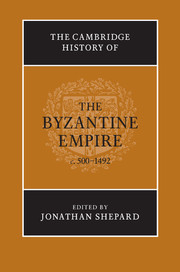Book contents
- Frontmatter
- General Introduction
- Part I The Earlier Empire c. 500–c. 700
- Part II The Middle Empire c. 700–1204
- 5 State of Emergency (700–850)
- 6 After Iconoclasm (850–886)
- 7 Religious Missions
- 8 Armenian Neighbours (600–1045)
- 9 Confronting Islam: Emperors Versus Caliphs (641–c. 850)
- 10 Western Approaches (700–900)
- 11 Byzantine Italy (680–876)
- 12 The Middle Byzantine Economy (600–1204)
- 13 Equilibrium to Expansion (886–1025)
- 14 Western Approaches (900–1025)
- 15 Byzantium and Southern Italy (876–1000)
- 16 Belle Époque or Crisis? (1025–1118)
- 17 The Empire of the Komnenoi (1118–1204)
- 18 Balkan Borderlands (1018–1204)
- 19 Raiders and Neighbours: The Turks (1040–1304)
- Part III The Byzantine Lands in the Later Middle Ages 1204–1492
- Glossary (Including some Proper Names)
- Genealogical Tables and Lists of Rulers
- List of alternative place names
- Bibliography
- Picture Acknowledgements
- Index
- References
8 - Armenian Neighbours (600–1045)
from Part II - The Middle Empire c. 700–1204
Published online by Cambridge University Press: 28 March 2010
- Frontmatter
- General Introduction
- Part I The Earlier Empire c. 500–c. 700
- Part II The Middle Empire c. 700–1204
- 5 State of Emergency (700–850)
- 6 After Iconoclasm (850–886)
- 7 Religious Missions
- 8 Armenian Neighbours (600–1045)
- 9 Confronting Islam: Emperors Versus Caliphs (641–c. 850)
- 10 Western Approaches (700–900)
- 11 Byzantine Italy (680–876)
- 12 The Middle Byzantine Economy (600–1204)
- 13 Equilibrium to Expansion (886–1025)
- 14 Western Approaches (900–1025)
- 15 Byzantium and Southern Italy (876–1000)
- 16 Belle Époque or Crisis? (1025–1118)
- 17 The Empire of the Komnenoi (1118–1204)
- 18 Balkan Borderlands (1018–1204)
- 19 Raiders and Neighbours: The Turks (1040–1304)
- Part III The Byzantine Lands in the Later Middle Ages 1204–1492
- Glossary (Including some Proper Names)
- Genealogical Tables and Lists of Rulers
- List of alternative place names
- Bibliography
- Picture Acknowledgements
- Index
- References
Summary
introduction
Anyone wishing to unravel the history of the relationship between Byzantium and Armenia from late antiquity into the eleventh century has to confront a series of historical and historiographical challenges. The most immediate, and intractable, of these is one of definition: what does ‘Armenia’ mean? Although Armenia is used to express a territorial entity in contemporary texts, both Armenian and non-Armenian in origin, its precise meaning varies according to the date and the context in which it is used. Far from finding a single, stable definition of Armenia, one discovers multiple ‘Armenias’. Thus a seventh-century Armenian geographical compilation depicts ‘Great Armenia’ as comprising not only regions currently recognised as Armenian but also those with historic associations. Successive provinces of Armenia were imposed and superimposed by external powers, each with a particular scope. The kingdom of Armenia, re-established in 884, bore little relation to its Arsacid precursor and increasingly represented only the Bagratuni kingdom centred on Ani, excluding rival kingdoms in Vaspurakan, Siwnik’ and elsewhere.
Given the absence of stable territorial boundaries and in the light of significant Arab settlement in certain districts from the end of the eighth century, there have been attempts to construct Armenian identity in terms of a blend of confessional, linguistic and cultural features. Once again the evidence supports a plural and inclusive definition. Instead of a community of believers, united around a single confession and recognising the spiritual authority of a single leader, the Armenian church embodied a spectrum of doctrinal interpretations, revolving largely, but not exclusively, around the acceptance or rejection of the council of Chalcedon.
- Type
- Chapter
- Information
- The Cambridge History of the Byzantine Empire c.500–1492 , pp. 333 - 364Publisher: Cambridge University PressPrint publication year: 2009
References
- 36
- Cited by

